Financial Investment Analysis: Appraisal Methods and Risk Assessment
VerifiedAdded on 2023/01/09
|16
|3840
|25
Homework Assignment
AI Summary
This assignment delves into the principles of financial investments, offering a detailed analysis of project appraisal techniques and risk assessment methodologies. The solution begins with a comprehensive calculation of the payback period, net present value (NPV), and internal rate of return (IRR) for a new project, evaluating its financial viability. It explores the reasons for setting a lower payback period and discusses the strengths and weaknesses of various investment techniques. Furthermore, the assignment examines the components of expected return on risky assets within the Capital Asset Pricing Model (CAPM), including risk-free rate, market risk premium, and beta. It includes calculations of expected return using CAPM, standard deviation, and beta measures. The analysis also covers the factors influencing dividend growth, features of ordinary equity and preference shares, and the determination of stock prices under different scenarios, including the impact of required returns. This assignment, available on Desklib, provides a thorough understanding of financial investment principles and practical application of investment appraisal techniques.

PRINCIPLES OF FINANCIAL
INVESTMENTS
INVESTMENTS
Paraphrase This Document
Need a fresh take? Get an instant paraphrase of this document with our AI Paraphraser
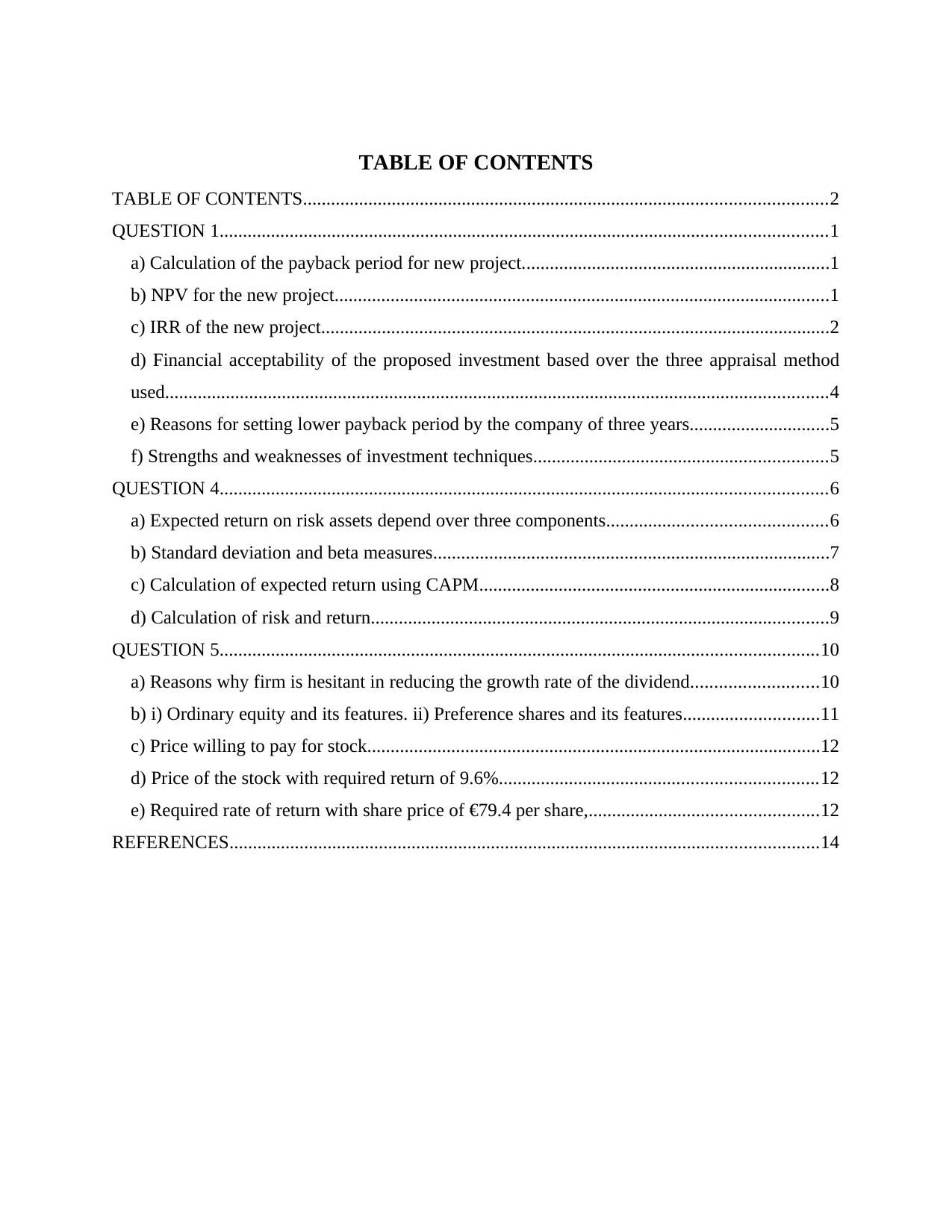
TABLE OF CONTENTS
TABLE OF CONTENTS................................................................................................................2
QUESTION 1..................................................................................................................................1
a) Calculation of the payback period for new project..................................................................1
b) NPV for the new project..........................................................................................................1
c) IRR of the new project.............................................................................................................2
d) Financial acceptability of the proposed investment based over the three appraisal method
used..............................................................................................................................................4
e) Reasons for setting lower payback period by the company of three years..............................5
f) Strengths and weaknesses of investment techniques...............................................................5
QUESTION 4..................................................................................................................................6
a) Expected return on risk assets depend over three components...............................................6
b) Standard deviation and beta measures.....................................................................................7
c) Calculation of expected return using CAPM...........................................................................8
d) Calculation of risk and return..................................................................................................9
QUESTION 5................................................................................................................................10
a) Reasons why firm is hesitant in reducing the growth rate of the dividend...........................10
b) i) Ordinary equity and its features. ii) Preference shares and its features.............................11
c) Price willing to pay for stock.................................................................................................12
d) Price of the stock with required return of 9.6%....................................................................12
e) Required rate of return with share price of €79.4 per share,.................................................12
REFERENCES..............................................................................................................................14
TABLE OF CONTENTS................................................................................................................2
QUESTION 1..................................................................................................................................1
a) Calculation of the payback period for new project..................................................................1
b) NPV for the new project..........................................................................................................1
c) IRR of the new project.............................................................................................................2
d) Financial acceptability of the proposed investment based over the three appraisal method
used..............................................................................................................................................4
e) Reasons for setting lower payback period by the company of three years..............................5
f) Strengths and weaknesses of investment techniques...............................................................5
QUESTION 4..................................................................................................................................6
a) Expected return on risk assets depend over three components...............................................6
b) Standard deviation and beta measures.....................................................................................7
c) Calculation of expected return using CAPM...........................................................................8
d) Calculation of risk and return..................................................................................................9
QUESTION 5................................................................................................................................10
a) Reasons why firm is hesitant in reducing the growth rate of the dividend...........................10
b) i) Ordinary equity and its features. ii) Preference shares and its features.............................11
c) Price willing to pay for stock.................................................................................................12
d) Price of the stock with required return of 9.6%....................................................................12
e) Required rate of return with share price of €79.4 per share,.................................................12
REFERENCES..............................................................................................................................14

QUESTION 1
a) Calculation of the payback period for new project.
Cost 210000
Terminal value 45000
Calculation of the cash
flows
Year 1 Year 2 Year 3 Year 4 Year 5
Sales 80000 96000 115200 92160 46080
Maintenance cost 20000 22000 24200 26620 29282
Net Cash Flows 60000 74000 91000 65540 16798
Computation of Payback period
Year
Cash
inflows
Cumulative cash
inflows
1 60000 60000
2 74000 134000
3 91000 225000
4 65540 290540
5 61798 352338
Initial
investment 210000
Payback
period 3
-0.2
Payback
period
2 years and 9.5
months
b) NPV for the new project
Computation of NPV
Year
Cash
inflows
PV factor
@ 15%
Discounted
cash inflows
1 60000 0.870 52173.913
2 74000 0.756 55955
3 91000 0.658 59834
4 65540 0.572 37473
1
a) Calculation of the payback period for new project.
Cost 210000
Terminal value 45000
Calculation of the cash
flows
Year 1 Year 2 Year 3 Year 4 Year 5
Sales 80000 96000 115200 92160 46080
Maintenance cost 20000 22000 24200 26620 29282
Net Cash Flows 60000 74000 91000 65540 16798
Computation of Payback period
Year
Cash
inflows
Cumulative cash
inflows
1 60000 60000
2 74000 134000
3 91000 225000
4 65540 290540
5 61798 352338
Initial
investment 210000
Payback
period 3
-0.2
Payback
period
2 years and 9.5
months
b) NPV for the new project
Computation of NPV
Year
Cash
inflows
PV factor
@ 15%
Discounted
cash inflows
1 60000 0.870 52173.913
2 74000 0.756 55955
3 91000 0.658 59834
4 65540 0.572 37473
1
⊘ This is a preview!⊘
Do you want full access?
Subscribe today to unlock all pages.

Trusted by 1+ million students worldwide

5 61798 0.497 30725
Total discounted cash
inflow 236160
Initial investment 210000
NPV (Total discounted
cash inflows - initial
investment) 26160
c) IRR of the new project
Step 1 : Selecting discount rates for calculation of NPVs
The discount rates 15%(R1) and 20%(R2) are taken as discount rates.
Step 2 : Calculation of the NPVs for investments using 2 discount rates.
Net Present Value at 15%
Computation of NPV
Year
Cash
inflows
PV
facto
r @
15%
Discounte
d cash
inflows
1 60000 0.870 52173.913
2 74000 0.756 55955
3 91000 0.658 59834
4 65540 0.572 37473
5 61798 0.497 30725
Total discounted cash
inflow 236160
Initial investment 210000
NPV (Total discounted
cash inflows - initial
investment) 26160
Net Present Value at 20%
Computation of NPV
2
Total discounted cash
inflow 236160
Initial investment 210000
NPV (Total discounted
cash inflows - initial
investment) 26160
c) IRR of the new project
Step 1 : Selecting discount rates for calculation of NPVs
The discount rates 15%(R1) and 20%(R2) are taken as discount rates.
Step 2 : Calculation of the NPVs for investments using 2 discount rates.
Net Present Value at 15%
Computation of NPV
Year
Cash
inflows
PV
facto
r @
15%
Discounte
d cash
inflows
1 60000 0.870 52173.913
2 74000 0.756 55955
3 91000 0.658 59834
4 65540 0.572 37473
5 61798 0.497 30725
Total discounted cash
inflow 236160
Initial investment 210000
NPV (Total discounted
cash inflows - initial
investment) 26160
Net Present Value at 20%
Computation of NPV
2
Paraphrase This Document
Need a fresh take? Get an instant paraphrase of this document with our AI Paraphraser
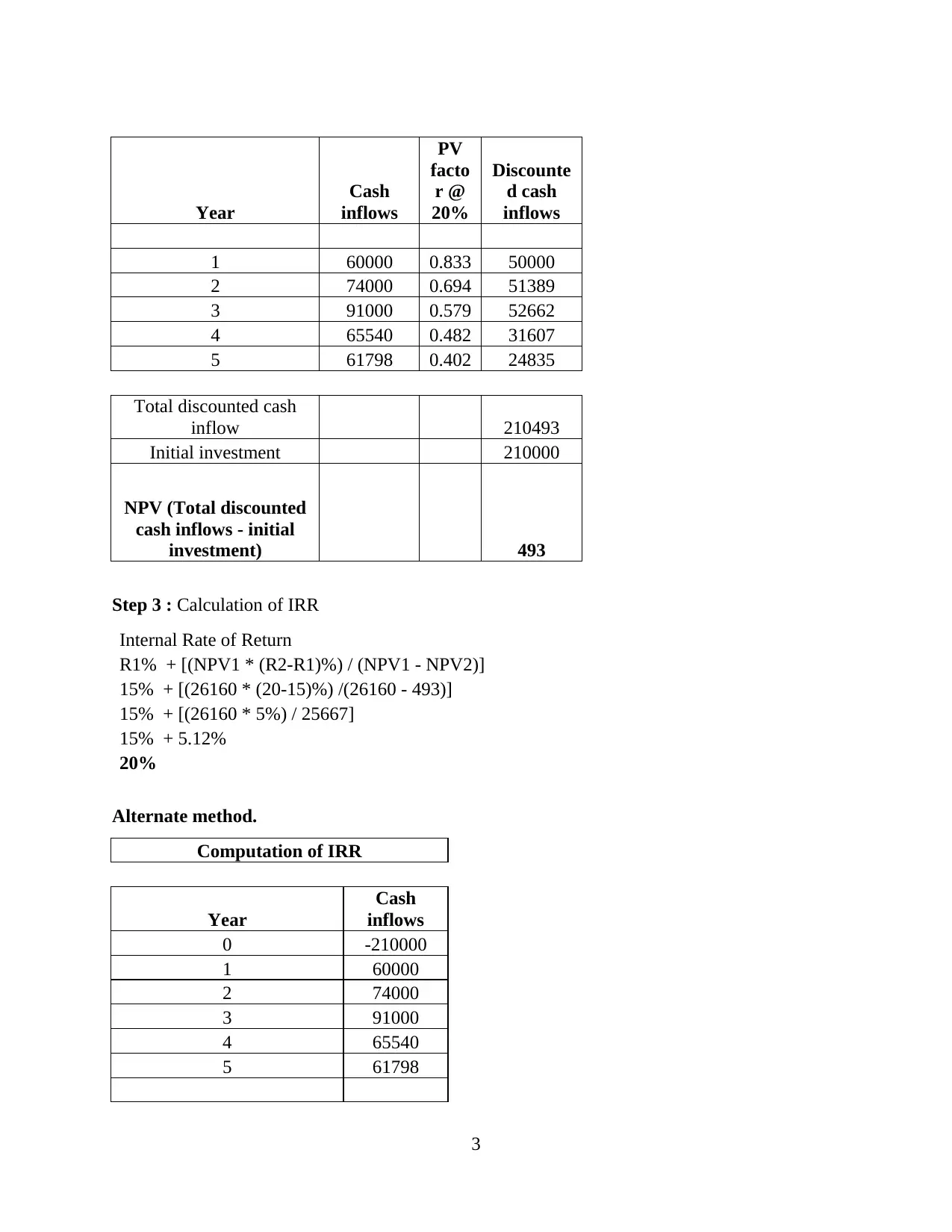
Year
Cash
inflows
PV
facto
r @
20%
Discounte
d cash
inflows
1 60000 0.833 50000
2 74000 0.694 51389
3 91000 0.579 52662
4 65540 0.482 31607
5 61798 0.402 24835
Total discounted cash
inflow 210493
Initial investment 210000
NPV (Total discounted
cash inflows - initial
investment) 493
Step 3 : Calculation of IRR
Internal Rate of Return
R1% + [(NPV1 * (R2-R1)%) / (NPV1 - NPV2)]
15% + [(26160 * (20-15)%) /(26160 - 493)]
15% + [(26160 * 5%) / 25667]
15% + 5.12%
20%
Alternate method.
Computation of IRR
Year
Cash
inflows
0 -210000
1 60000
2 74000
3 91000
4 65540
5 61798
3
Cash
inflows
PV
facto
r @
20%
Discounte
d cash
inflows
1 60000 0.833 50000
2 74000 0.694 51389
3 91000 0.579 52662
4 65540 0.482 31607
5 61798 0.402 24835
Total discounted cash
inflow 210493
Initial investment 210000
NPV (Total discounted
cash inflows - initial
investment) 493
Step 3 : Calculation of IRR
Internal Rate of Return
R1% + [(NPV1 * (R2-R1)%) / (NPV1 - NPV2)]
15% + [(26160 * (20-15)%) /(26160 - 493)]
15% + [(26160 * 5%) / 25667]
15% + 5.12%
20%
Alternate method.
Computation of IRR
Year
Cash
inflows
0 -210000
1 60000
2 74000
3 91000
4 65540
5 61798
3
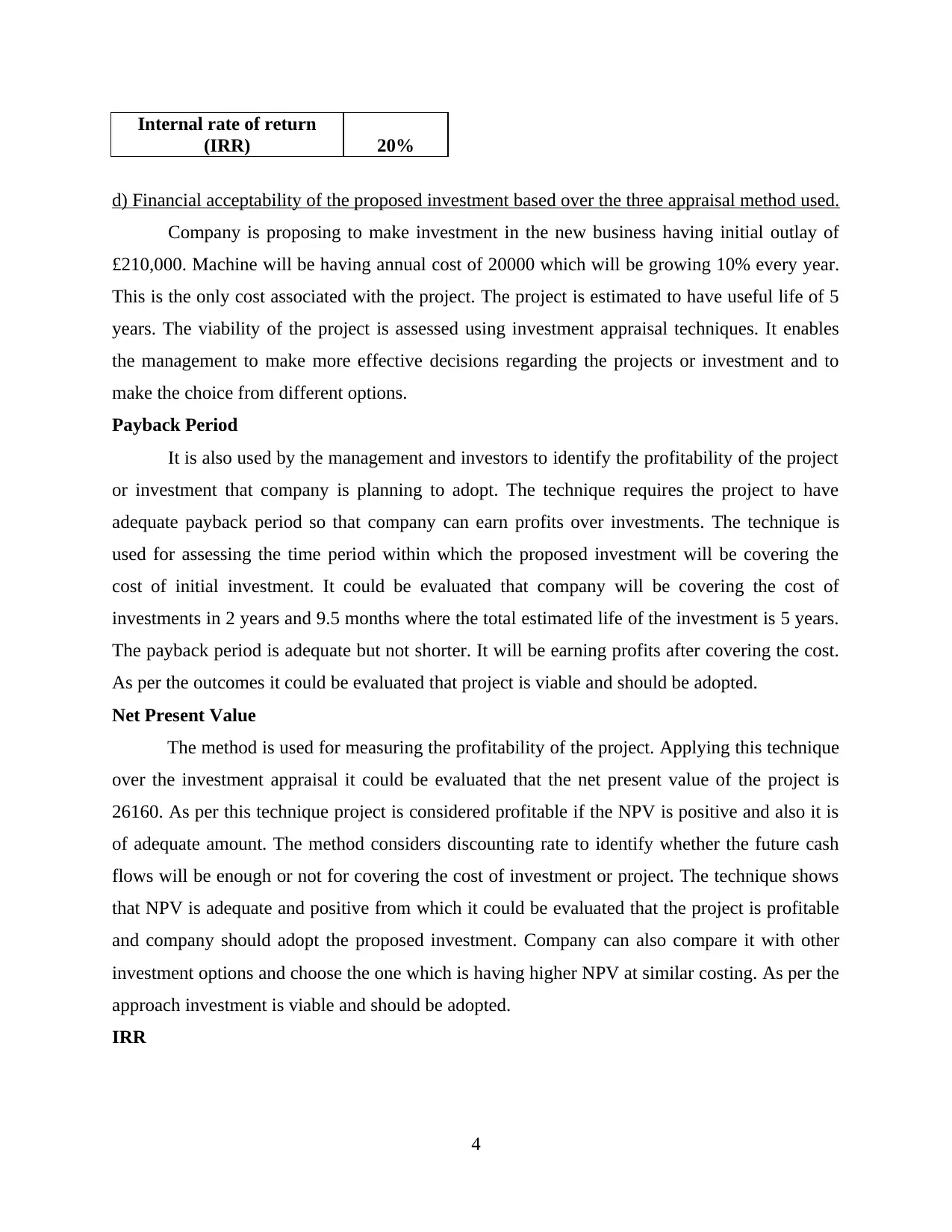
Internal rate of return
(IRR) 20%
d) Financial acceptability of the proposed investment based over the three appraisal method used.
Company is proposing to make investment in the new business having initial outlay of
£210,000. Machine will be having annual cost of 20000 which will be growing 10% every year.
This is the only cost associated with the project. The project is estimated to have useful life of 5
years. The viability of the project is assessed using investment appraisal techniques. It enables
the management to make more effective decisions regarding the projects or investment and to
make the choice from different options.
Payback Period
It is also used by the management and investors to identify the profitability of the project
or investment that company is planning to adopt. The technique requires the project to have
adequate payback period so that company can earn profits over investments. The technique is
used for assessing the time period within which the proposed investment will be covering the
cost of initial investment. It could be evaluated that company will be covering the cost of
investments in 2 years and 9.5 months where the total estimated life of the investment is 5 years.
The payback period is adequate but not shorter. It will be earning profits after covering the cost.
As per the outcomes it could be evaluated that project is viable and should be adopted.
Net Present Value
The method is used for measuring the profitability of the project. Applying this technique
over the investment appraisal it could be evaluated that the net present value of the project is
26160. As per this technique project is considered profitable if the NPV is positive and also it is
of adequate amount. The method considers discounting rate to identify whether the future cash
flows will be enough or not for covering the cost of investment or project. The technique shows
that NPV is adequate and positive from which it could be evaluated that the project is profitable
and company should adopt the proposed investment. Company can also compare it with other
investment options and choose the one which is having higher NPV at similar costing. As per the
approach investment is viable and should be adopted.
IRR
4
(IRR) 20%
d) Financial acceptability of the proposed investment based over the three appraisal method used.
Company is proposing to make investment in the new business having initial outlay of
£210,000. Machine will be having annual cost of 20000 which will be growing 10% every year.
This is the only cost associated with the project. The project is estimated to have useful life of 5
years. The viability of the project is assessed using investment appraisal techniques. It enables
the management to make more effective decisions regarding the projects or investment and to
make the choice from different options.
Payback Period
It is also used by the management and investors to identify the profitability of the project
or investment that company is planning to adopt. The technique requires the project to have
adequate payback period so that company can earn profits over investments. The technique is
used for assessing the time period within which the proposed investment will be covering the
cost of initial investment. It could be evaluated that company will be covering the cost of
investments in 2 years and 9.5 months where the total estimated life of the investment is 5 years.
The payback period is adequate but not shorter. It will be earning profits after covering the cost.
As per the outcomes it could be evaluated that project is viable and should be adopted.
Net Present Value
The method is used for measuring the profitability of the project. Applying this technique
over the investment appraisal it could be evaluated that the net present value of the project is
26160. As per this technique project is considered profitable if the NPV is positive and also it is
of adequate amount. The method considers discounting rate to identify whether the future cash
flows will be enough or not for covering the cost of investment or project. The technique shows
that NPV is adequate and positive from which it could be evaluated that the project is profitable
and company should adopt the proposed investment. Company can also compare it with other
investment options and choose the one which is having higher NPV at similar costing. As per the
approach investment is viable and should be adopted.
IRR
4
⊘ This is a preview!⊘
Do you want full access?
Subscribe today to unlock all pages.

Trusted by 1+ million students worldwide
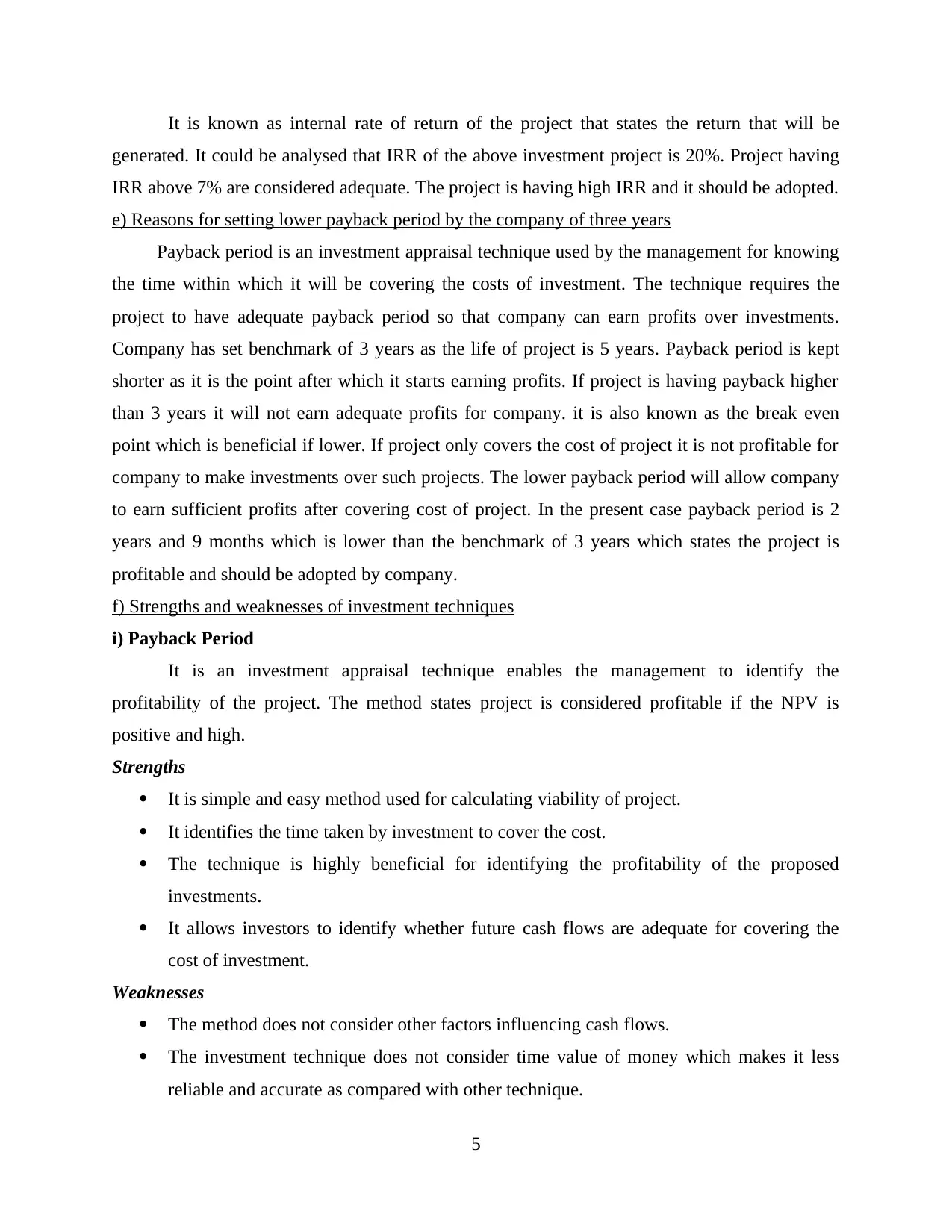
It is known as internal rate of return of the project that states the return that will be
generated. It could be analysed that IRR of the above investment project is 20%. Project having
IRR above 7% are considered adequate. The project is having high IRR and it should be adopted.
e) Reasons for setting lower payback period by the company of three years
Payback period is an investment appraisal technique used by the management for knowing
the time within which it will be covering the costs of investment. The technique requires the
project to have adequate payback period so that company can earn profits over investments.
Company has set benchmark of 3 years as the life of project is 5 years. Payback period is kept
shorter as it is the point after which it starts earning profits. If project is having payback higher
than 3 years it will not earn adequate profits for company. it is also known as the break even
point which is beneficial if lower. If project only covers the cost of project it is not profitable for
company to make investments over such projects. The lower payback period will allow company
to earn sufficient profits after covering cost of project. In the present case payback period is 2
years and 9 months which is lower than the benchmark of 3 years which states the project is
profitable and should be adopted by company.
f) Strengths and weaknesses of investment techniques
i) Payback Period
It is an investment appraisal technique enables the management to identify the
profitability of the project. The method states project is considered profitable if the NPV is
positive and high.
Strengths
It is simple and easy method used for calculating viability of project.
It identifies the time taken by investment to cover the cost.
The technique is highly beneficial for identifying the profitability of the proposed
investments.
It allows investors to identify whether future cash flows are adequate for covering the
cost of investment.
Weaknesses
The method does not consider other factors influencing cash flows.
The investment technique does not consider time value of money which makes it less
reliable and accurate as compared with other technique.
5
generated. It could be analysed that IRR of the above investment project is 20%. Project having
IRR above 7% are considered adequate. The project is having high IRR and it should be adopted.
e) Reasons for setting lower payback period by the company of three years
Payback period is an investment appraisal technique used by the management for knowing
the time within which it will be covering the costs of investment. The technique requires the
project to have adequate payback period so that company can earn profits over investments.
Company has set benchmark of 3 years as the life of project is 5 years. Payback period is kept
shorter as it is the point after which it starts earning profits. If project is having payback higher
than 3 years it will not earn adequate profits for company. it is also known as the break even
point which is beneficial if lower. If project only covers the cost of project it is not profitable for
company to make investments over such projects. The lower payback period will allow company
to earn sufficient profits after covering cost of project. In the present case payback period is 2
years and 9 months which is lower than the benchmark of 3 years which states the project is
profitable and should be adopted by company.
f) Strengths and weaknesses of investment techniques
i) Payback Period
It is an investment appraisal technique enables the management to identify the
profitability of the project. The method states project is considered profitable if the NPV is
positive and high.
Strengths
It is simple and easy method used for calculating viability of project.
It identifies the time taken by investment to cover the cost.
The technique is highly beneficial for identifying the profitability of the proposed
investments.
It allows investors to identify whether future cash flows are adequate for covering the
cost of investment.
Weaknesses
The method does not consider other factors influencing cash flows.
The investment technique does not consider time value of money which makes it less
reliable and accurate as compared with other technique.
5
Paraphrase This Document
Need a fresh take? Get an instant paraphrase of this document with our AI Paraphraser
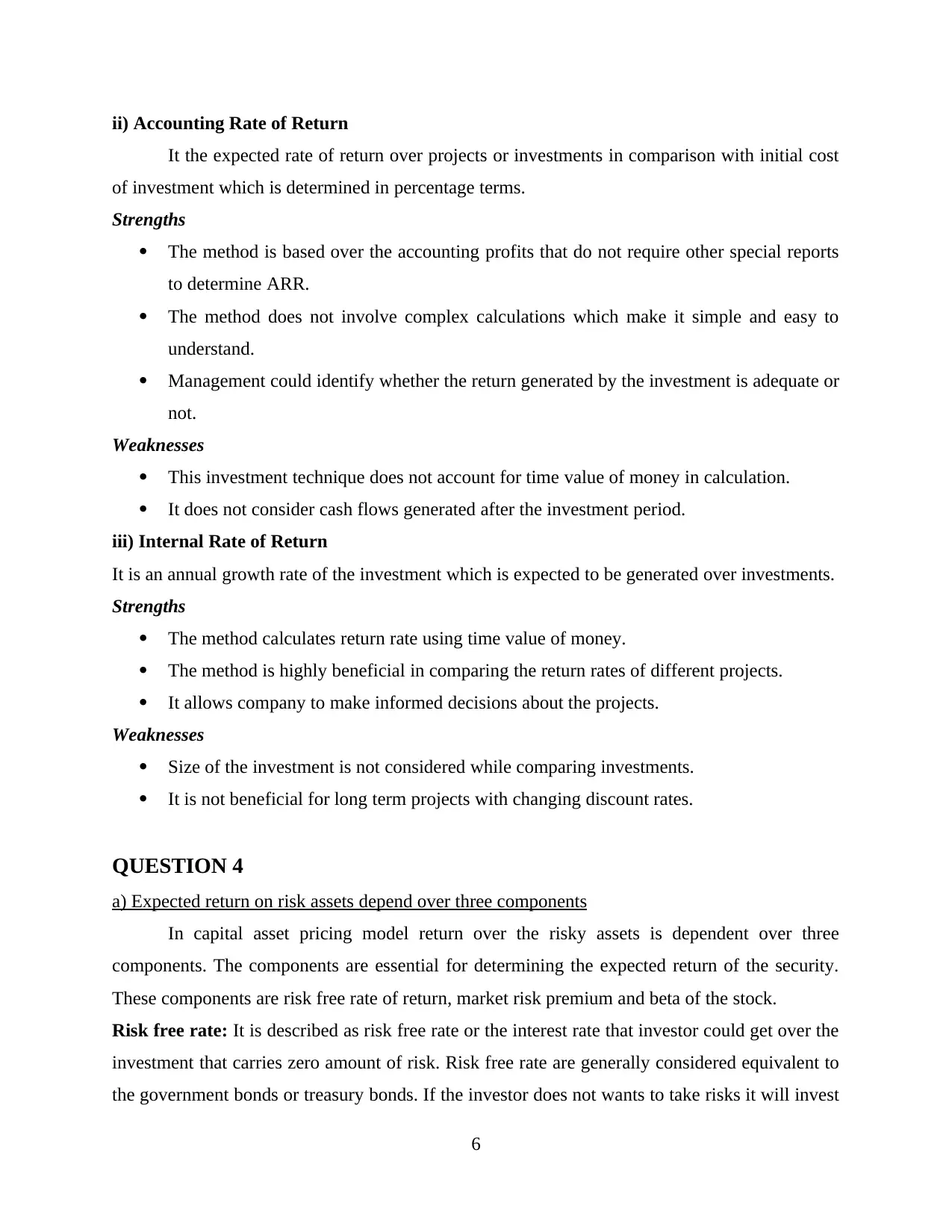
ii) Accounting Rate of Return
It the expected rate of return over projects or investments in comparison with initial cost
of investment which is determined in percentage terms.
Strengths
The method is based over the accounting profits that do not require other special reports
to determine ARR.
The method does not involve complex calculations which make it simple and easy to
understand.
Management could identify whether the return generated by the investment is adequate or
not.
Weaknesses
This investment technique does not account for time value of money in calculation.
It does not consider cash flows generated after the investment period.
iii) Internal Rate of Return
It is an annual growth rate of the investment which is expected to be generated over investments.
Strengths
The method calculates return rate using time value of money.
The method is highly beneficial in comparing the return rates of different projects.
It allows company to make informed decisions about the projects.
Weaknesses
Size of the investment is not considered while comparing investments.
It is not beneficial for long term projects with changing discount rates.
QUESTION 4
a) Expected return on risk assets depend over three components
In capital asset pricing model return over the risky assets is dependent over three
components. The components are essential for determining the expected return of the security.
These components are risk free rate of return, market risk premium and beta of the stock.
Risk free rate: It is described as risk free rate or the interest rate that investor could get over the
investment that carries zero amount of risk. Risk free rate are generally considered equivalent to
the government bonds or treasury bonds. If the investor does not wants to take risks it will invest
6
It the expected rate of return over projects or investments in comparison with initial cost
of investment which is determined in percentage terms.
Strengths
The method is based over the accounting profits that do not require other special reports
to determine ARR.
The method does not involve complex calculations which make it simple and easy to
understand.
Management could identify whether the return generated by the investment is adequate or
not.
Weaknesses
This investment technique does not account for time value of money in calculation.
It does not consider cash flows generated after the investment period.
iii) Internal Rate of Return
It is an annual growth rate of the investment which is expected to be generated over investments.
Strengths
The method calculates return rate using time value of money.
The method is highly beneficial in comparing the return rates of different projects.
It allows company to make informed decisions about the projects.
Weaknesses
Size of the investment is not considered while comparing investments.
It is not beneficial for long term projects with changing discount rates.
QUESTION 4
a) Expected return on risk assets depend over three components
In capital asset pricing model return over the risky assets is dependent over three
components. The components are essential for determining the expected return of the security.
These components are risk free rate of return, market risk premium and beta of the stock.
Risk free rate: It is described as risk free rate or the interest rate that investor could get over the
investment that carries zero amount of risk. Risk free rate are generally considered equivalent to
the government bonds or treasury bonds. If the investor does not wants to take risks it will invest
6
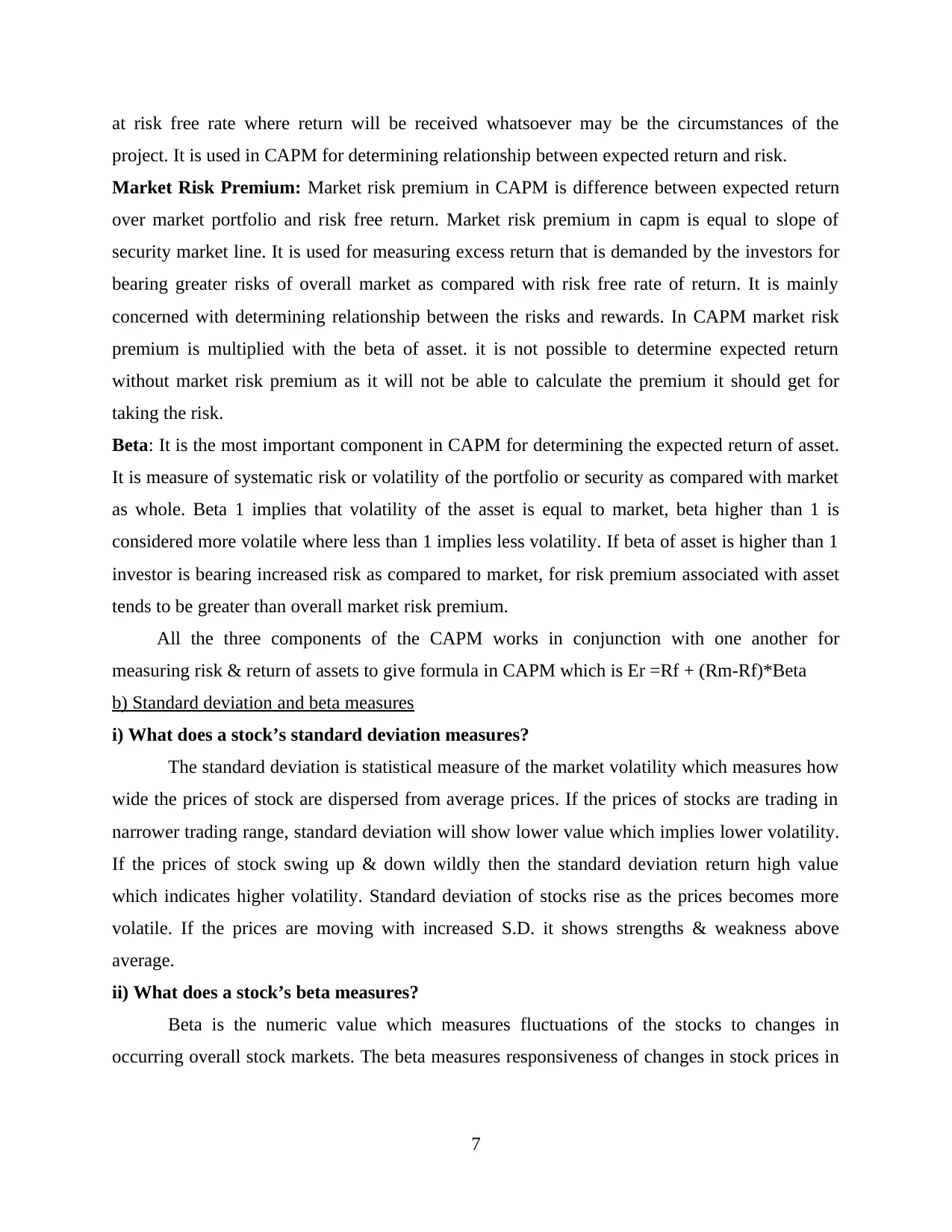
at risk free rate where return will be received whatsoever may be the circumstances of the
project. It is used in CAPM for determining relationship between expected return and risk.
Market Risk Premium: Market risk premium in CAPM is difference between expected return
over market portfolio and risk free return. Market risk premium in capm is equal to slope of
security market line. It is used for measuring excess return that is demanded by the investors for
bearing greater risks of overall market as compared with risk free rate of return. It is mainly
concerned with determining relationship between the risks and rewards. In CAPM market risk
premium is multiplied with the beta of asset. it is not possible to determine expected return
without market risk premium as it will not be able to calculate the premium it should get for
taking the risk.
Beta: It is the most important component in CAPM for determining the expected return of asset.
It is measure of systematic risk or volatility of the portfolio or security as compared with market
as whole. Beta 1 implies that volatility of the asset is equal to market, beta higher than 1 is
considered more volatile where less than 1 implies less volatility. If beta of asset is higher than 1
investor is bearing increased risk as compared to market, for risk premium associated with asset
tends to be greater than overall market risk premium.
All the three components of the CAPM works in conjunction with one another for
measuring risk & return of assets to give formula in CAPM which is Er =Rf + (Rm-Rf)*Beta
b) Standard deviation and beta measures
i) What does a stock’s standard deviation measures?
The standard deviation is statistical measure of the market volatility which measures how
wide the prices of stock are dispersed from average prices. If the prices of stocks are trading in
narrower trading range, standard deviation will show lower value which implies lower volatility.
If the prices of stock swing up & down wildly then the standard deviation return high value
which indicates higher volatility. Standard deviation of stocks rise as the prices becomes more
volatile. If the prices are moving with increased S.D. it shows strengths & weakness above
average.
ii) What does a stock’s beta measures?
Beta is the numeric value which measures fluctuations of the stocks to changes in
occurring overall stock markets. The beta measures responsiveness of changes in stock prices in
7
project. It is used in CAPM for determining relationship between expected return and risk.
Market Risk Premium: Market risk premium in CAPM is difference between expected return
over market portfolio and risk free return. Market risk premium in capm is equal to slope of
security market line. It is used for measuring excess return that is demanded by the investors for
bearing greater risks of overall market as compared with risk free rate of return. It is mainly
concerned with determining relationship between the risks and rewards. In CAPM market risk
premium is multiplied with the beta of asset. it is not possible to determine expected return
without market risk premium as it will not be able to calculate the premium it should get for
taking the risk.
Beta: It is the most important component in CAPM for determining the expected return of asset.
It is measure of systematic risk or volatility of the portfolio or security as compared with market
as whole. Beta 1 implies that volatility of the asset is equal to market, beta higher than 1 is
considered more volatile where less than 1 implies less volatility. If beta of asset is higher than 1
investor is bearing increased risk as compared to market, for risk premium associated with asset
tends to be greater than overall market risk premium.
All the three components of the CAPM works in conjunction with one another for
measuring risk & return of assets to give formula in CAPM which is Er =Rf + (Rm-Rf)*Beta
b) Standard deviation and beta measures
i) What does a stock’s standard deviation measures?
The standard deviation is statistical measure of the market volatility which measures how
wide the prices of stock are dispersed from average prices. If the prices of stocks are trading in
narrower trading range, standard deviation will show lower value which implies lower volatility.
If the prices of stock swing up & down wildly then the standard deviation return high value
which indicates higher volatility. Standard deviation of stocks rise as the prices becomes more
volatile. If the prices are moving with increased S.D. it shows strengths & weakness above
average.
ii) What does a stock’s beta measures?
Beta is the numeric value which measures fluctuations of the stocks to changes in
occurring overall stock markets. The beta measures responsiveness of changes in stock prices in
7
⊘ This is a preview!⊘
Do you want full access?
Subscribe today to unlock all pages.

Trusted by 1+ million students worldwide
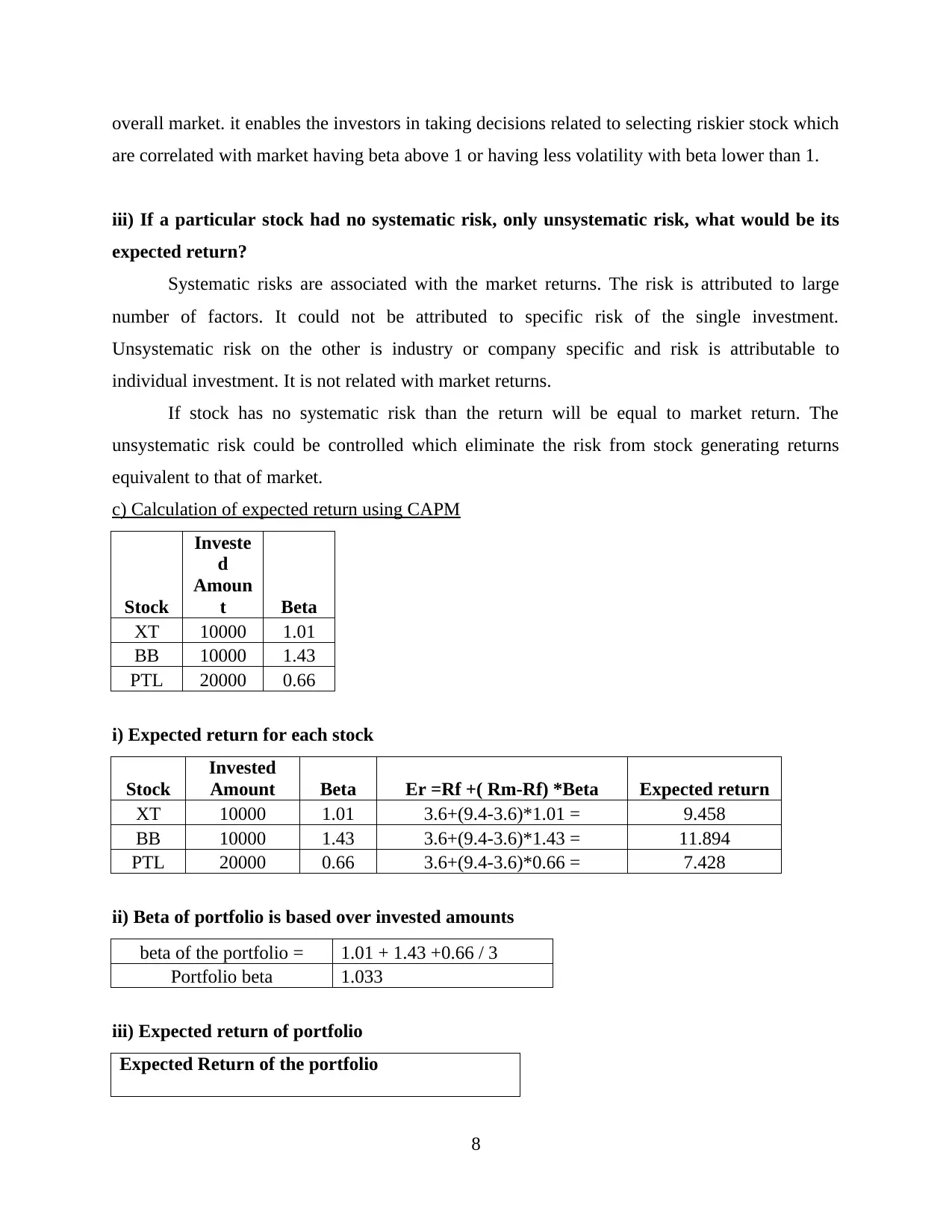
overall market. it enables the investors in taking decisions related to selecting riskier stock which
are correlated with market having beta above 1 or having less volatility with beta lower than 1.
iii) If a particular stock had no systematic risk, only unsystematic risk, what would be its
expected return?
Systematic risks are associated with the market returns. The risk is attributed to large
number of factors. It could not be attributed to specific risk of the single investment.
Unsystematic risk on the other is industry or company specific and risk is attributable to
individual investment. It is not related with market returns.
If stock has no systematic risk than the return will be equal to market return. The
unsystematic risk could be controlled which eliminate the risk from stock generating returns
equivalent to that of market.
c) Calculation of expected return using CAPM
Stock
Investe
d
Amoun
t Beta
XT 10000 1.01
BB 10000 1.43
PTL 20000 0.66
i) Expected return for each stock
Stock
Invested
Amount Beta Er =Rf +( Rm-Rf) *Beta Expected return
XT 10000 1.01 3.6+(9.4-3.6)*1.01 = 9.458
BB 10000 1.43 3.6+(9.4-3.6)*1.43 = 11.894
PTL 20000 0.66 3.6+(9.4-3.6)*0.66 = 7.428
ii) Beta of portfolio is based over invested amounts
beta of the portfolio = 1.01 + 1.43 +0.66 / 3
Portfolio beta 1.033
iii) Expected return of portfolio
Expected Return of the portfolio
8
are correlated with market having beta above 1 or having less volatility with beta lower than 1.
iii) If a particular stock had no systematic risk, only unsystematic risk, what would be its
expected return?
Systematic risks are associated with the market returns. The risk is attributed to large
number of factors. It could not be attributed to specific risk of the single investment.
Unsystematic risk on the other is industry or company specific and risk is attributable to
individual investment. It is not related with market returns.
If stock has no systematic risk than the return will be equal to market return. The
unsystematic risk could be controlled which eliminate the risk from stock generating returns
equivalent to that of market.
c) Calculation of expected return using CAPM
Stock
Investe
d
Amoun
t Beta
XT 10000 1.01
BB 10000 1.43
PTL 20000 0.66
i) Expected return for each stock
Stock
Invested
Amount Beta Er =Rf +( Rm-Rf) *Beta Expected return
XT 10000 1.01 3.6+(9.4-3.6)*1.01 = 9.458
BB 10000 1.43 3.6+(9.4-3.6)*1.43 = 11.894
PTL 20000 0.66 3.6+(9.4-3.6)*0.66 = 7.428
ii) Beta of portfolio is based over invested amounts
beta of the portfolio = 1.01 + 1.43 +0.66 / 3
Portfolio beta 1.033
iii) Expected return of portfolio
Expected Return of the portfolio
8
Paraphrase This Document
Need a fresh take? Get an instant paraphrase of this document with our AI Paraphraser
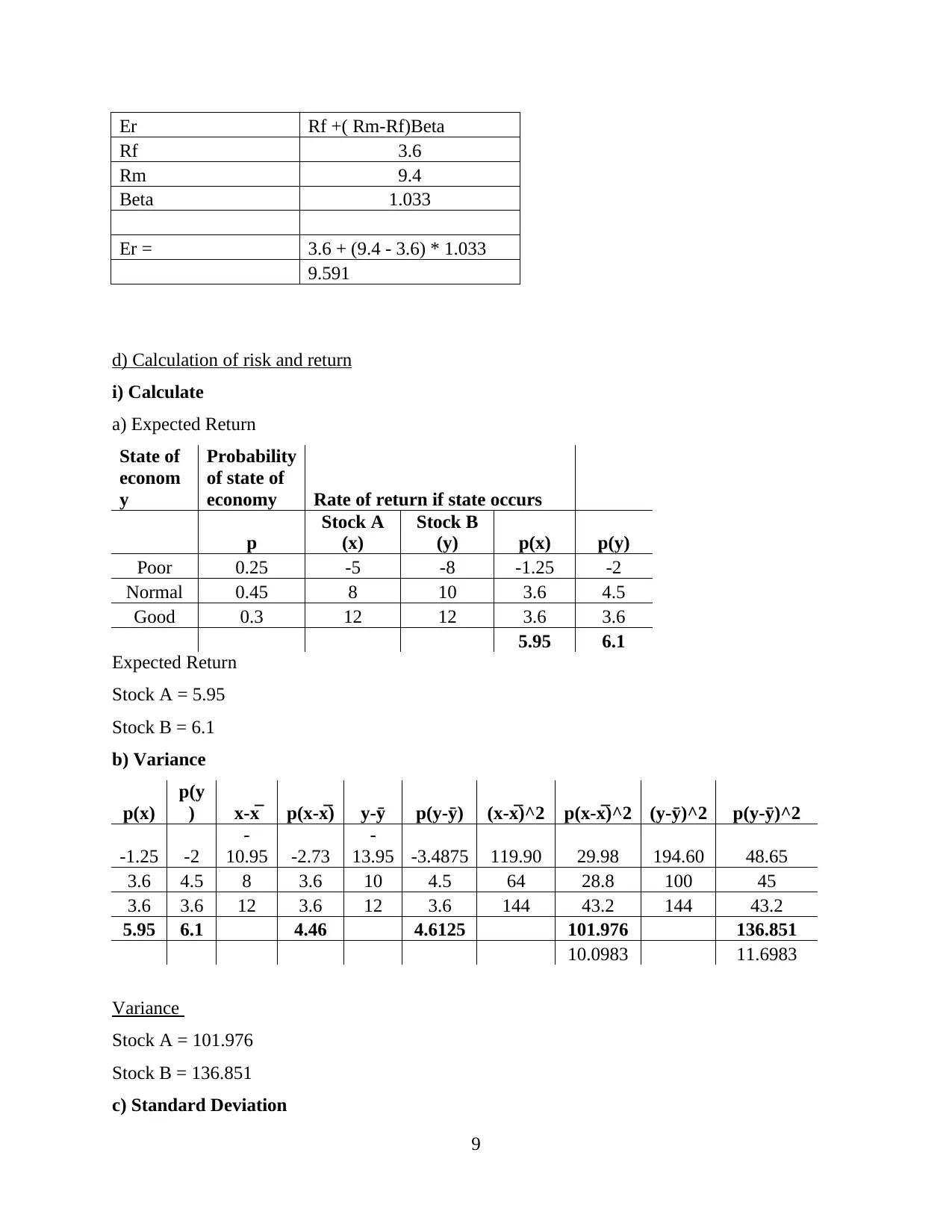
Er Rf +( Rm-Rf)Beta
Rf 3.6
Rm 9.4
Beta 1.033
Er = 3.6 + (9.4 - 3.6) * 1.033
9.591
d) Calculation of risk and return
i) Calculate
a) Expected Return
State of
econom
y
Probability
of state of
economy Rate of return if state occurs
p
Stock A
(x)
Stock B
(y) p(x) p(y)
Poor 0.25 -5 -8 -1.25 -2
Normal 0.45 8 10 3.6 4.5
Good 0.3 12 12 3.6 3.6
5.95 6.1
Expected Return
Stock A = 5.95
Stock B = 6.1
b) Variance
p(x)
p(y
) x-x̅ p(x-x̅) y-ȳ p(y-ȳ) (x-x̅)^2 p(x-x̅)^2 (y-ȳ)^2 p(y-ȳ)^2
-1.25 -2
-
10.95 -2.73
-
13.95 -3.4875 119.90 29.98 194.60 48.65
3.6 4.5 8 3.6 10 4.5 64 28.8 100 45
3.6 3.6 12 3.6 12 3.6 144 43.2 144 43.2
5.95 6.1 4.46 4.6125 101.976 136.851
10.0983 11.6983
Variance
Stock A = 101.976
Stock B = 136.851
c) Standard Deviation
9
Rf 3.6
Rm 9.4
Beta 1.033
Er = 3.6 + (9.4 - 3.6) * 1.033
9.591
d) Calculation of risk and return
i) Calculate
a) Expected Return
State of
econom
y
Probability
of state of
economy Rate of return if state occurs
p
Stock A
(x)
Stock B
(y) p(x) p(y)
Poor 0.25 -5 -8 -1.25 -2
Normal 0.45 8 10 3.6 4.5
Good 0.3 12 12 3.6 3.6
5.95 6.1
Expected Return
Stock A = 5.95
Stock B = 6.1
b) Variance
p(x)
p(y
) x-x̅ p(x-x̅) y-ȳ p(y-ȳ) (x-x̅)^2 p(x-x̅)^2 (y-ȳ)^2 p(y-ȳ)^2
-1.25 -2
-
10.95 -2.73
-
13.95 -3.4875 119.90 29.98 194.60 48.65
3.6 4.5 8 3.6 10 4.5 64 28.8 100 45
3.6 3.6 12 3.6 12 3.6 144 43.2 144 43.2
5.95 6.1 4.46 4.6125 101.976 136.851
10.0983 11.6983
Variance
Stock A = 101.976
Stock B = 136.851
c) Standard Deviation
9
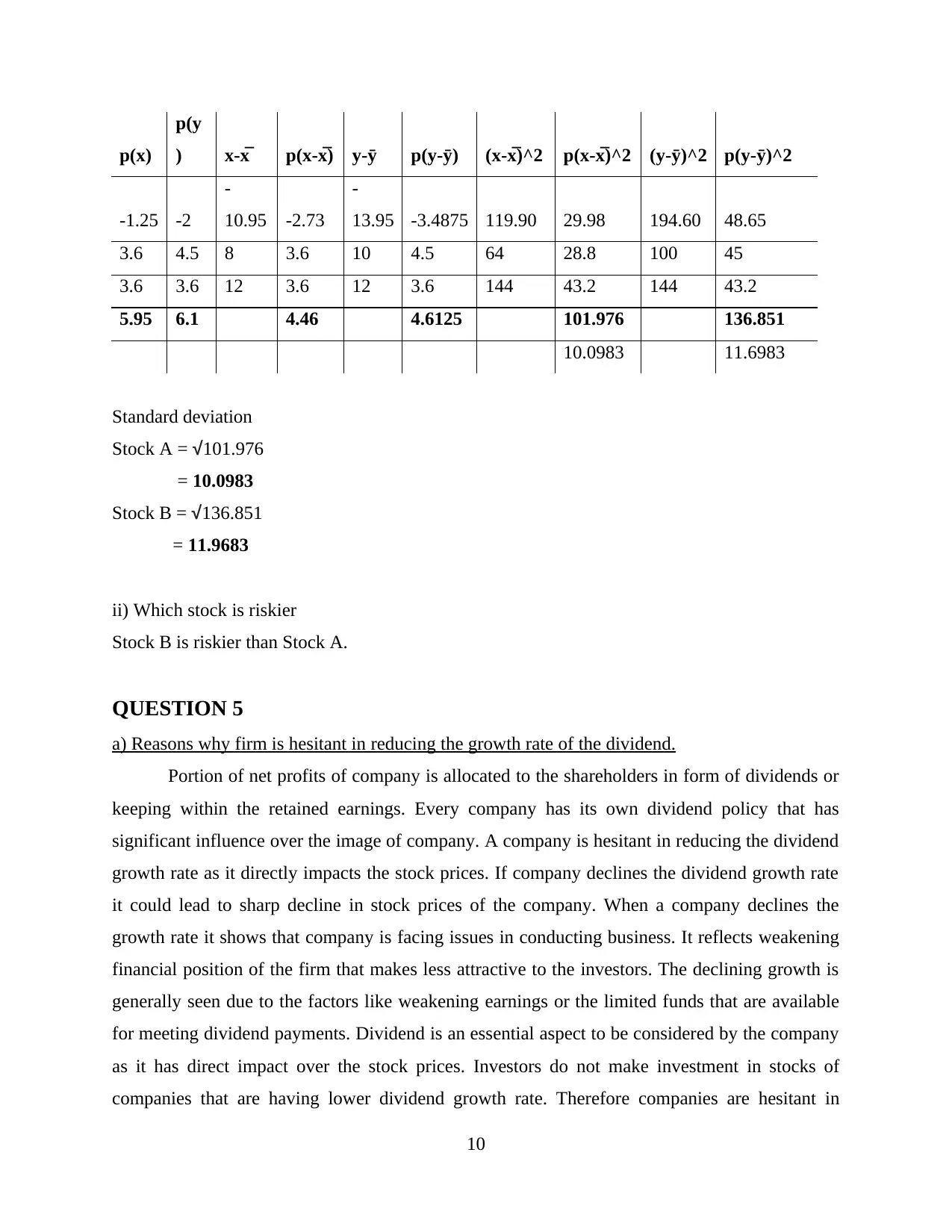
p(x)
p(y
) x-x̅ p(x-x̅) y-ȳ p(y-ȳ) (x-x̅)^2 p(x-x̅)^2 (y-ȳ)^2 p(y-ȳ)^2
-1.25 -2
-
10.95 -2.73
-
13.95 -3.4875 119.90 29.98 194.60 48.65
3.6 4.5 8 3.6 10 4.5 64 28.8 100 45
3.6 3.6 12 3.6 12 3.6 144 43.2 144 43.2
5.95 6.1 4.46 4.6125 101.976 136.851
10.0983 11.6983
Standard deviation
Stock A = √101.976
= 10.0983
Stock B = √136.851
= 11.9683
ii) Which stock is riskier
Stock B is riskier than Stock A.
QUESTION 5
a) Reasons why firm is hesitant in reducing the growth rate of the dividend.
Portion of net profits of company is allocated to the shareholders in form of dividends or
keeping within the retained earnings. Every company has its own dividend policy that has
significant influence over the image of company. A company is hesitant in reducing the dividend
growth rate as it directly impacts the stock prices. If company declines the dividend growth rate
it could lead to sharp decline in stock prices of the company. When a company declines the
growth rate it shows that company is facing issues in conducting business. It reflects weakening
financial position of the firm that makes less attractive to the investors. The declining growth is
generally seen due to the factors like weakening earnings or the limited funds that are available
for meeting dividend payments. Dividend is an essential aspect to be considered by the company
as it has direct impact over the stock prices. Investors do not make investment in stocks of
companies that are having lower dividend growth rate. Therefore companies are hesitant in
10
p(y
) x-x̅ p(x-x̅) y-ȳ p(y-ȳ) (x-x̅)^2 p(x-x̅)^2 (y-ȳ)^2 p(y-ȳ)^2
-1.25 -2
-
10.95 -2.73
-
13.95 -3.4875 119.90 29.98 194.60 48.65
3.6 4.5 8 3.6 10 4.5 64 28.8 100 45
3.6 3.6 12 3.6 12 3.6 144 43.2 144 43.2
5.95 6.1 4.46 4.6125 101.976 136.851
10.0983 11.6983
Standard deviation
Stock A = √101.976
= 10.0983
Stock B = √136.851
= 11.9683
ii) Which stock is riskier
Stock B is riskier than Stock A.
QUESTION 5
a) Reasons why firm is hesitant in reducing the growth rate of the dividend.
Portion of net profits of company is allocated to the shareholders in form of dividends or
keeping within the retained earnings. Every company has its own dividend policy that has
significant influence over the image of company. A company is hesitant in reducing the dividend
growth rate as it directly impacts the stock prices. If company declines the dividend growth rate
it could lead to sharp decline in stock prices of the company. When a company declines the
growth rate it shows that company is facing issues in conducting business. It reflects weakening
financial position of the firm that makes less attractive to the investors. The declining growth is
generally seen due to the factors like weakening earnings or the limited funds that are available
for meeting dividend payments. Dividend is an essential aspect to be considered by the company
as it has direct impact over the stock prices. Investors do not make investment in stocks of
companies that are having lower dividend growth rate. Therefore companies are hesitant in
10
⊘ This is a preview!⊘
Do you want full access?
Subscribe today to unlock all pages.

Trusted by 1+ million students worldwide
1 out of 16
Related Documents
Your All-in-One AI-Powered Toolkit for Academic Success.
+13062052269
info@desklib.com
Available 24*7 on WhatsApp / Email
![[object Object]](/_next/static/media/star-bottom.7253800d.svg)
Unlock your academic potential
Copyright © 2020–2025 A2Z Services. All Rights Reserved. Developed and managed by ZUCOL.



